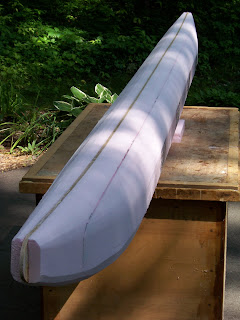Late in the summer I started building a styrofoam and fiber glass ama for an outrigger canoe.
I followed Gary Dierking's advice posted
here.
It's been fun and rewarding. I learned a lot.
I definitely gained some skill at this amazing technique that's been used to build hundreds of thousands of surf boards.This post shows the first steps of carving and shaping the styrofoam.Check out Tim Anderson's interview (including videos) of a surfboard shaper on Maui --- top tips --- especially on power planer mods: Build a Surfboard Episode 1: ShapingI designed the ama with my 2D CAD software,
DeltaCAD ($39.95).
I highly recommend this drawing software if you're new to CAD. "The world's easiest CAD software."
I rough cut out the 12' foot long shear web from 5-ply, 1/4" Baltic birch underlayment from Menard's using an electric jig saw.
I shaved off the remaining 1/8" or so with a Stanley block plane to ensure the outline of the shear web was fair.
 Sharpen your block plane on a water stone for daily Zen practice.
Sharpen your block plane on a water stone for daily Zen practice.

Then I bonded 2 layers of high density, 2" thick, extruded styrofoam to both sides of the shear web with marine epoxy thickened with microspheres.
I ordered the epoxy and microspheres from
Glen-L Marine (Poxy-Shield and Microspheres filler).
I ripped the 2"x4'x8' sheets of pink styrofoam down to 10" wide strips on my table saw -- really a budget bench saw built into a extension table.
The first photo shows the resulting sandwich being rough cut (to within no less than 1/8" inch of the final shape). A Japanese pull saw, or one of the domestic versions (shown) works very well indeed, as Gary Dierking points out, and goes quite fast . . .
The second shows the power planer I used to obtain the final cross section. I duct-taped a Shop Vac hose to the planer's chip outlet. Note that Shop Vacs are NOT designed for continuous duty, so work for no more than 5 minutes at a time.
WARNING! CAUTION! AS WITH ALL POWER WOODWORKING TOOLS --- BE VERY CAREFUL OF THAT SPINNING BLADE!

After reading Tim Anderson's
'ible , I want to swap out my shaper blades with a spiral shaping barrel like the ones the surfboard shapers use:

But they sell for $375 Australian dollars !?!?!
And they seem way overkill for shaping styrofoam. I wonder if there's an ultralight pneumatic tool out there that does the same thing?
And the final cross section:

Then I transferred the lines for the plan section:

. . . and used several tools to trim away the excess material: pull saw, power planer, sanding board, sanding block. . .

 Next I removed material from the hard chines, to ultimately get an elliptical cross section...
Next I removed material from the hard chines, to ultimately get an elliptical cross section... Here I'm getting closer to the ellipse, but there's a lot of fairling with a long sanding board left to go.
Here I'm getting closer to the ellipse, but there's a lot of fairling with a long sanding board left to go.

















